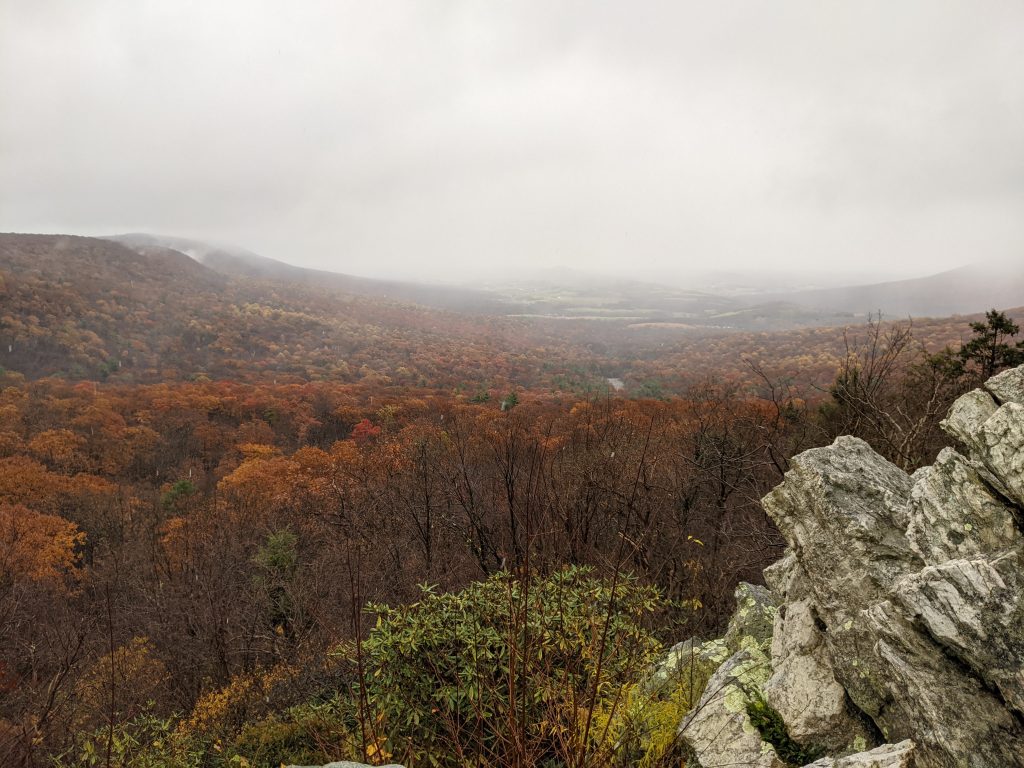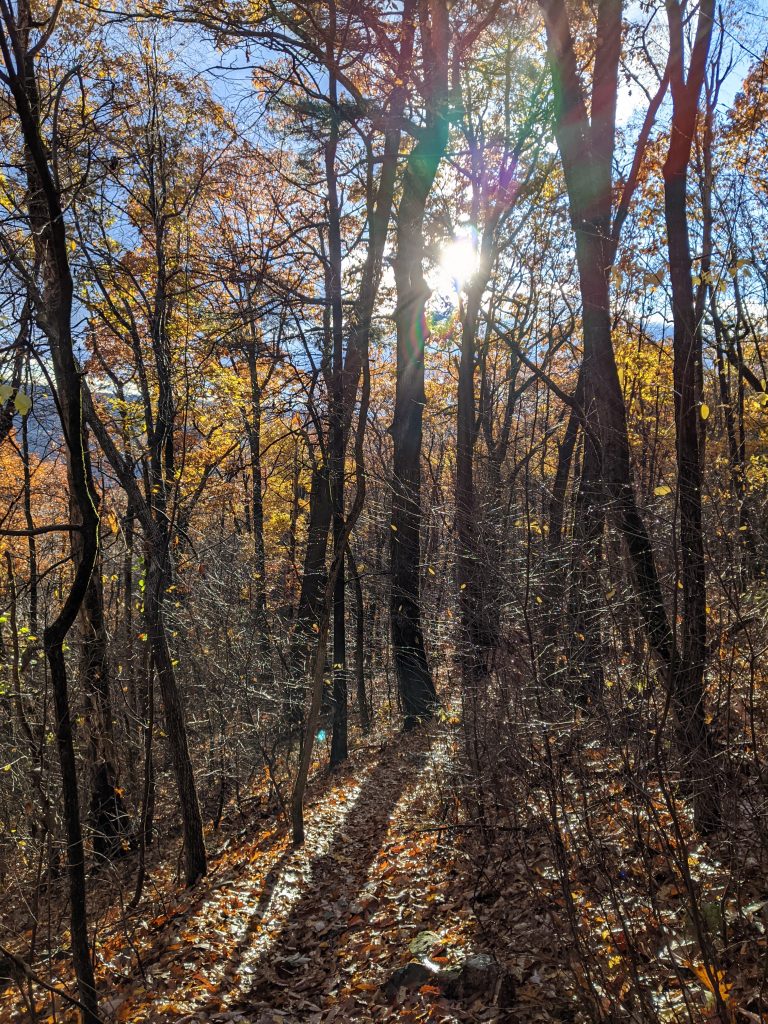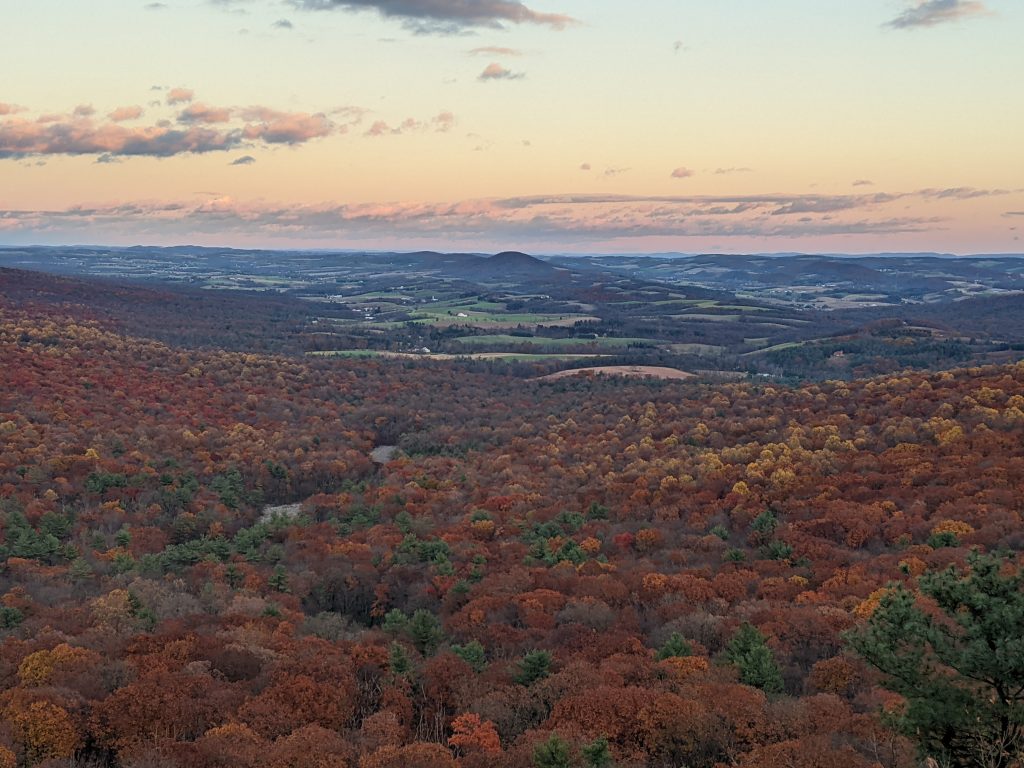Mountains in the fall offer the intrepid all four seasons in an afternoon. The unpredictability is usually simply chaotic rather than dangerous, a reminder that the future is neither guaranteed nor able to be tamed. A chilly November Saturday at the Hawk Mountain Sanctuary in east-central Pennsylvania provides a winter preview of snow, rain to remind one of a faded spring, the bright sunshine of summer, and the brilliant colors of autumn.
At midday, chilly weather brings snow flurries and fog that obscures a normally panoramic and far-flung view, reining it in to a mile or two at best. The highest elevation hovers around 1,500 feet, but the fog could trick visitors into thinking they have an extra 1,000 feet to separate them from the sea. An hour later, and clear patches in the sky expand as the fog admits defeat, revealing what was once hidden to visiting hikers. Another hour passes, and the golden hour arrives to awaken a luminescent forest before darkness reclaims it.

Founded in 1934 by conservationist Rosalie Edge, Hawk Mountain bills itself as the first refuge for birds of prey. The site was a popular hunting ground for hawks, eagles, and falcons due to its location along the migration path of many raptors in North America. Edge converted the land from hunting ground to hiking ground, birdwatcher’s Nirvana, and educational center.
The weather, however, keeps most birds away this Saturday. Aside from a few chickadees and crows, the birds demur on flying through the snow and the sleet.
Regardless, Hawk Mountain has something in its favor. The vibrancy of the forest, even with low visibility, makes one forget about the bitter cold through which one must climb. The yellows, reds, and oranges of oak, maple, birch, and hickory trees light up every overlook. The green of stubborn pine, spruce, and magnolia trees keep balance. And the brown bark of trees that already shed their leaves give a hint of what is to come.

Trails at Hawk Mountain tend to run along the Kittatinny Ridge or dive down the hillside, crossing creeks and gullies. The ridge portions give hikers some phenomenal views east and north, of rolling hills and farms and meandering roads. The cost of the view is rocky terrain, requiring confident steps and jumps across rocks and boulders. A trail loop may only be 5 or 6 miles, but it will take 4 or 5 hours.
Get across the ridge, though, and the woods engulf. Nathaniel Hawthorne described the foreboding danger within the forests of Puritan New England, Washington Irving wrote of the supernatural lying within the Hudson Valley, but the woodlands of the Alleghenies have had less attention. They might be more quiet when the snow silences it in winter, but fall brings out Appalachian gothic.

Car engines cease, encounters with other hikers fade, and a certain lull sets in. The crying of a crow overhead disturbs a running thought. A rabbit or squirrel rustles leaves as it darts under a bush or climbs a tree. Something feels unsettling until a deer lunges away, breaking its cover and the gaze it held on what was trundling toward it. Coming upon the River of Rocks, a mile-long boulder field 40 feet deep at one point, makes for an unusual, if not unnatural, view.
Forests in Appalachia have a certain sameness to them; the details may differ, but go far enough into them, and the rolling hills, the rock faces, the creeks and ravines and fauna, overlap. It’s enough to blue the particulars and make each hike feel like one forms into the next, and all could be united on the other side of the hill or around the bend. It’s a familiar dislocation. Where one finds an overgrown cemetery from the frontier in the foothills, it resembles what’s found in the river valley or the snowy mountains. The same kind of winding road, sometimes paved and sometimes not, takes one past farms, trailers, bed and breakfast rentals, the occasional country store…It can be comforting or disquieting, depending on whether the soul wants to feel rooted or wants to flee.

Certain contrasts, however, can be found. Looking north while atop one boulder cluster, wind turbines ride a distant hill line. To the east, farmland encircles a knob of a hill (or is it a lonely mountain?). Follow the ridge far enough and it links up with the Appalachian Trail, taking hikers to Maine or Georgia depending on whether they want peaches or lobster.
Regardless, the land teaches humility. A misstep on a boulder could mean slow, painful hours back to a road, or worse. As the sun sets, anxiety replaces it. The comforts of home and food delivery feel far away without a phone signal. Otherwise, though, the forest returns us to a human scale of life. A self-propelled pace, a focus beyond an immediate payoff, the ability to be cut off from the society around us goes a long way to reorienting thought and life to something beyond our grasp. Hawk Mountain may not have had many raptors on that Saturday, but it offered something more than a view.

Subscribe to The Patch, our newsletter, to stay up-to-date with new expatalachians articles and news from around Appalachia.
Anthony Hennen is managing editor of expatalachians and executive editor of Philadelphia Weekly.


